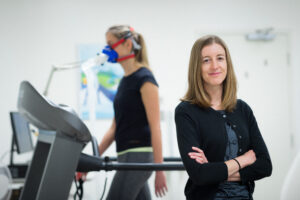In “past, present, future”, we ask clinical or academic experts to reflect on selected Sports & Exercise Medicine topics. Today Kristin Campbell on Exercise Oncology.

Tell us more about yourself.
I am a licensed physiotherapist and PhD-trained researcher from Canada. My primary role is as a Professor and the Associate Head of Research in the Department of Physical Therapy at the University of British Columbia (BC). I also hold an appointment in the Cancer Control Program at the BC Cancer Research Institute. I had the privilege to help develop the original Cancer Exercise Specialist certification from the American College of Sports Medicine (ACSM) in 2008 and co-lead the 2019 exercise guidelines for cancer survivors from the ACSM with my colleague Dr Kerri Winters-Stone. I am active in the field of exercise rehabilitation in oncology research, using study designs from feasibility testing to implementation studies in collaboration with clinical and community partners.
What was hip and happening 10 years ago?
Ten years ago, the first exercise guidelines for individuals following a cancer diagnosis had just been published in 2010 by the ACSM. While there were some specific recommendations based on the type of cancer or treatment received, the general guidelines were for people to aim for the same physical activity guidelines for the general population (i.e., 150 min/wk moderate-intensity aerobic exercise & 2x/wk strength training sessions). While having cancer-specific guidelines was well received by exercise professionals, some felt these guidelines were too high a bar, such that it might discourage some individuals from even trying exercise, or it may not be appropriate for individuals with higher symptoms or disease burden. In addition, the majority of available research was primarily in people with breast or prostate cancer, so the guidelines were based on extrapolating this data to make general recommendations for all people with cancer.
What are we doing now?
There has been exponential growth in the field of exercise oncology research in the last 10 years. There is more research involving people with types of cancer other than breast and prostate cancer. Further advances in research include a focus on how exercise may improve treatment tolerance and management of treatment side effects and how to implement programs at scale, including examining cost-effectiveness. In 2019, updated exercise guidelines were published from ACSM. This time the process was more international and interdisciplinary, with endorsements from 15 professional organisations worldwide. These guidelines report an approximately 40% decrease in all-cause of death in people with breast, colorectal and prostate cancer who are physically active after diagnosis; provide specific exercise prescription recommendations to manage common side effects of cancer treatments where benefit is seen with a lower amount of exercise than outlined in the 2010 guidelines (i.e., 90 mins/wk moderate-intensity exercise alone or 2x/wk strength training alone, or a combination); and promote the use of “ask, advice, refer” as a way for healthcare providers working in the oncology setting to connect more people to exercise programming during and following cancer treatment.
Where do you think we will be 10 years from now?
I believe that in 10 years, we will have more insight into the roles of physical activity and exercise as an adjunct to cancer treatments. There is an increasing focus on exercise in pre-clinical cancer research, which may shed more light on the biological mechanisms for the beneficial effects of physical activity and exercise in cancer prevention, symptom management and survivorship, which have been more elusive to date in biomarkers studies in human. Furthermore, the COVID-19 pandemic has allowed research and exercise professionals to re-think how to deliver supervised, progressive exercise prescriptions using virtual technology. This will undoubtedly spark new ways to improve the reach of services that in the past were limited to specialised programs often only available in large metropolitan centres. My hope is that the current generation of implementation research studies, such as SafeFIT in the UK (https://safefit.nhs.uk/ and other knowledge translation initiatives, such as Exercise is Medicine – Moving Through Cancer (https://www.exerciseismedicine.org/eim-in-action/moving-through-cancer/), help to make accessible exercise and rehabilitation programming part of the standard of care in oncology by 2031 regardless of ability to pay.